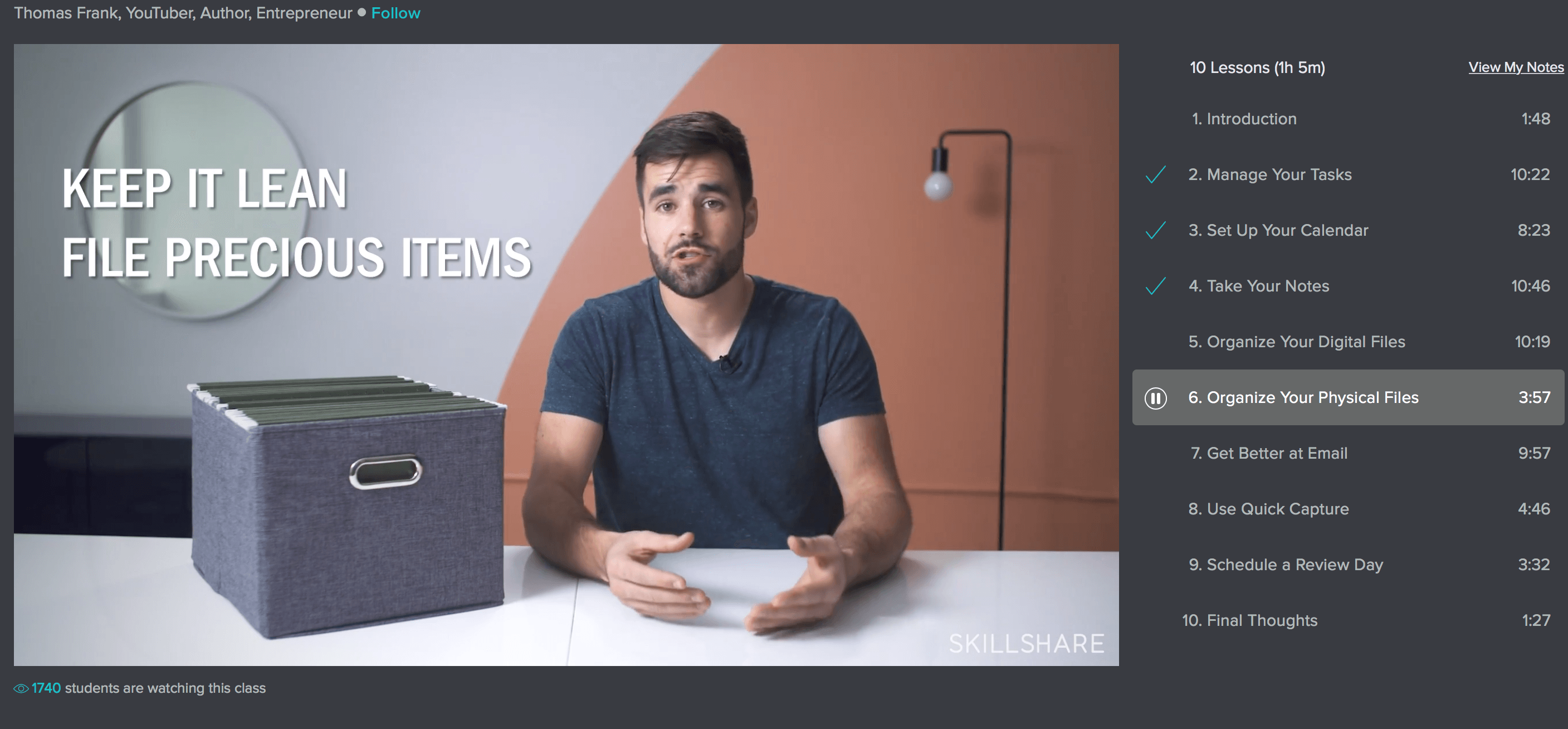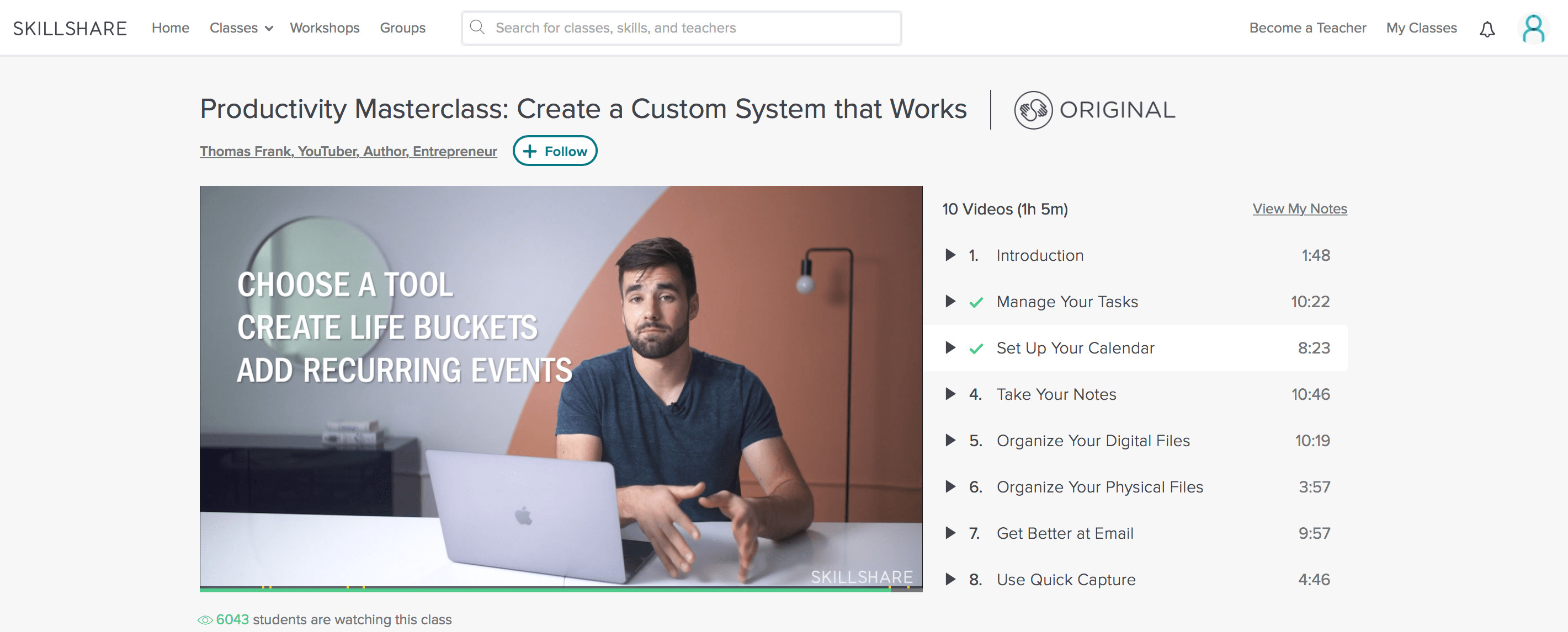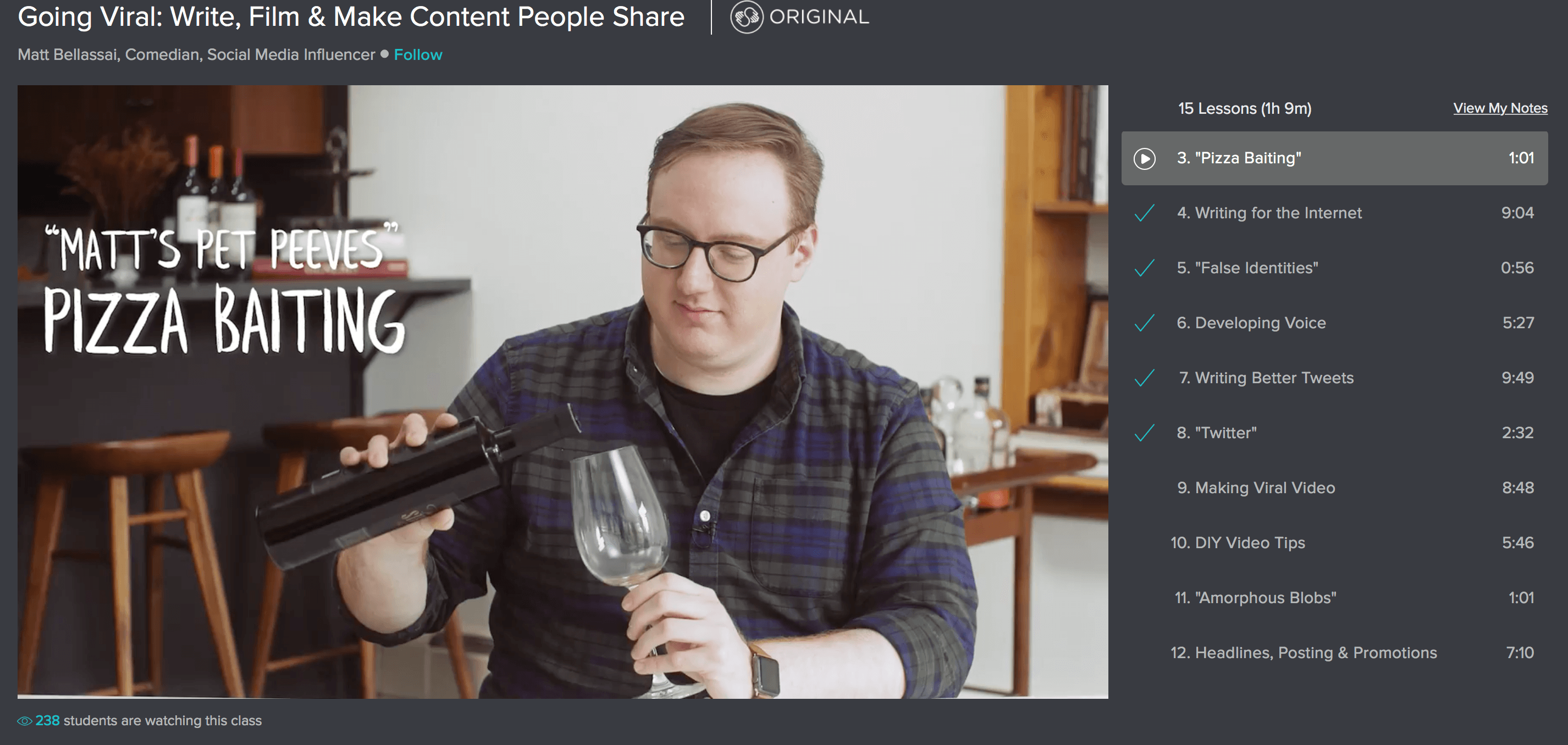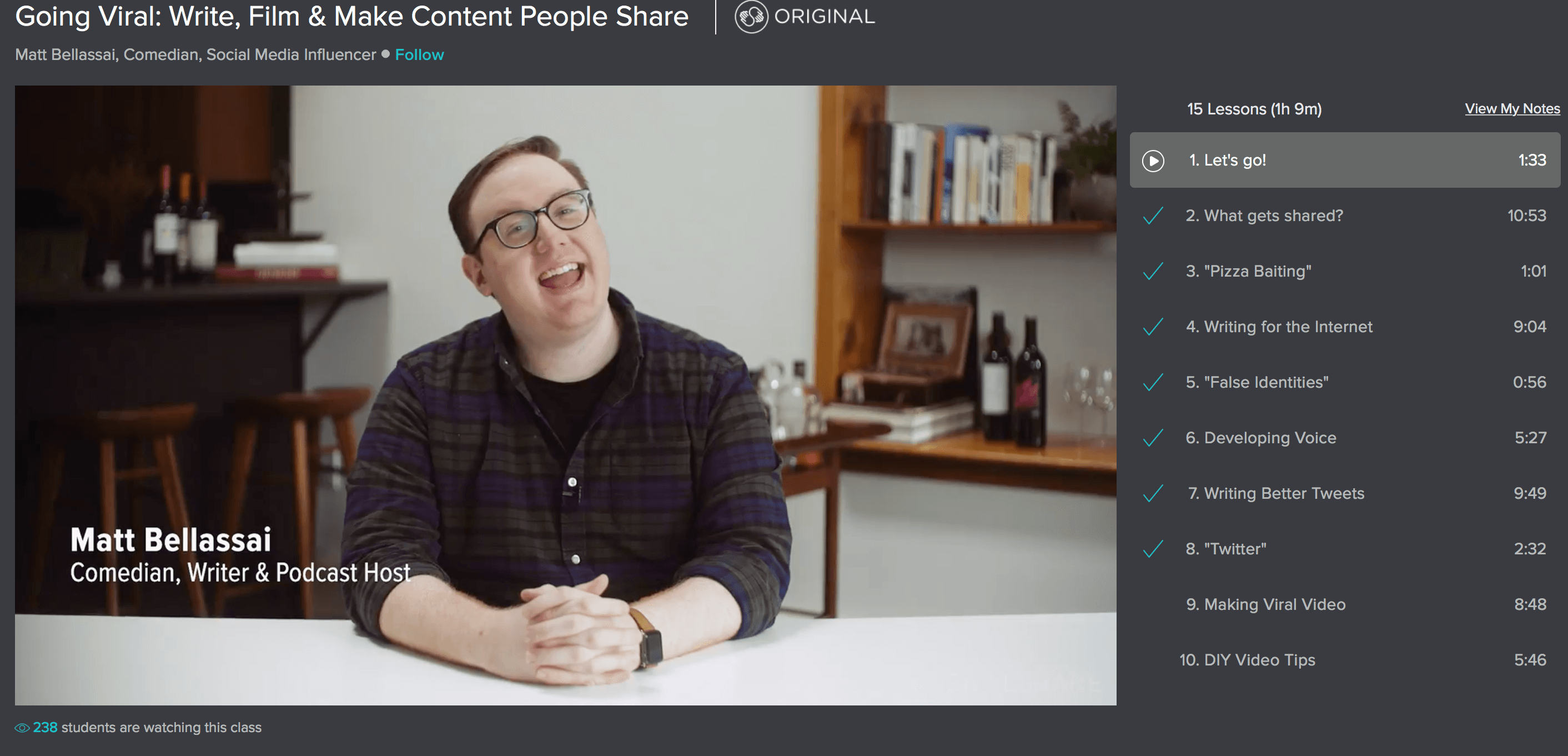I finally signed up to Skillshare for four reasons:
- A contact at the company reached out and asked if I’d like to teach a course. Obviously I had to see what kind of courses were the norm over there before formulating my own.
- Thomas Frank’s course looked extremely valuable.
- The catalogue as a whole looked like a great prize. So many courses relevant to the things I need to learn, plus tons more I didn’t even know I’d be interested in that look fascinating.
- How can you argue with Skillshare’s lengthy free trial? No risk, so why not?
Skillshare Review (2019) Is It Worth It?
This Skillshare review will assess the platform on two levels:
- What is Skillshare like for creators?
- What is Skillshare like for students?
We will kick this Skillshare review off by answering whether I recommend Skillshare for creators.
Then I’ll review two specific courses on the platform that I’ve taken and enjoyed:
- Thomas Frank’s Productivity MasterClass
- Matt Bellassai’s Going Viral
I’ll also review Skillshare as a whole, what I think is great, areas for improvement, and complete thoughts.
This Skillshare review is going to be impartial, but it’s important you know what my potential biases are.
The first bias is I’m a creator myself, so I have an invested interest in the platform keeping its good reputation. My course is niche though so I’m not expecting any conversions in this Skillshare review to my course (unless you’re currently applying for universities).
My other bias is that I’m an affiliate for Skillshare. If you sign up with my link, you’ll get two months free access to Skillshare and I’ll also get a commission if you stick with them after the trial period. If you find this review useful, I’d appreciate you checking out Skillshare through my link because it’s a win-win for both of us.
Now let’s get into the review!
What’s Skillshare like for creators?
I think Skillshare is perfect for the beginner course-creator.
A really wonderful woman from Skillshare reached out to me at the beginning of this year to see if I was interested in producing a course, which was serendipitous because it had been on my mind a long time.
I was consulting and wanted to scale my knowledge. But I was overwhelmed about where to start. Hands down, the contact at Skillshare was a significant driving factor in getting my course up and running. She was motivating, gave me a ton of positive and constructive feedback to improve my course and helped push it through to completion.
Related Reading:
I can’t emphasise enough just how impressed I was with Skillshare’s support for creators.
I’ve had quite a few companies reach out to me over the years for projects and had negotiated with even more companies on behalf of my clients and I’m telling you it really stands out when companies employ the right people.
There are so many content companies out there that treat the lifeblood of their company, the creators, as though they were wage-slaves that they control. I’ve walked away from more offers than I can count simply because I refuse to work with unpleasant or controlling people. What a breath of fresh air to deal with a company that knows how to treat its partners!
Another great benefit to Skillshare as a creator is the referral and membership system.
If someone signs up to your course, you get a cut.
If you recommend the course, or any of the other courses or just the platform in general, you also get a cut.
The student base is around 3 million.
That’s a respectable amount of eyeballs.
If you’re mostly interested in getting your name out there/just having people watch you, Skillshare is great for that because they offer very generous free trials (this one’s 2 months). So the barrier for people signing up is way lower than if they’d have to think about paying.
This is great for someone who is not well-known yet. I could put together a course with a high price tag and host it myself, but unless I dump a load of money on aggressive advertising I won’t get a huge amount of sign-ups off the bat because I’m relatively unknown.
Skillshare, however, already has the audience and the marketing channels, both internally and externally, which you can benefit from. It’s also an established name with some built-in authority.
Conversely, you might not get the audience you want.
If there’s a price on the course/no free trial, less people will take it but the ones who do will have considered it more.
I’ve taken courses purely based on the fact I’ve got a free trial instead of actually caring about the instructor’s message. I’ve also paid hundreds of dollars for courses purely because I want that exact information from that exact person.
It all comes down to what you want to achieve with your course.
But I personally think Skillshare ranks as a perfect platform for beginners and even people who already have a sizeable audience.
Case in point being Thomas Frank. I took his course and we’ll get into the review for that in a minute. But Thomas already had around a million+ subscribers on his YouTube channel when he was approached by Skillshare. Through the platform he pulled over $15,000 in one month and I believe his authority combined with the authority and elegance of the Skillshare platform, along with their enticing free trial, helped raise that amount.
Get a feel for Skillshare by following this link. You’ll get a free trial so you can take a look around.
So I would 100% recommend Skillshare for content creators.
The platform has a lot of big names and a respectable audience already, but I believe it’s still in its infancy stage considering what it could become.
I predict that within a few more years, you’ll see a lot more recognisable names on the platform (I could even make specific predictions for who, but I’ll keep that to myself).
So my advice is to get on the elevator while it’s going up. There’s a huge benefit to being an early adopter of anything!
Now let’s review two of my favourite Skillshare courses. I took more than two, but these are the ones that stood out for me personally.
Thomas Frank Productivity Masterclass Review
Every student should take Thomas Frank’s Skillshare course.
I figured out how best to be productive and organised but only by my final year at university. I was so disorganised in my first two years and it really damaged my potential. To think, all I would have needed to get more out of my Oxford studies would have been to take this short course and commit to applying it.
Thomas makes his productivity systems intuitive, easy to adhere to, even fun, and, dare I say it, sexy,
Thomas gets straight into the meat in this course. Exactly what you want from a course that’s an hour.
Immediately applicable advice, do this, do this, for this reason, then do this for this reason.
This is very appealing to someone who hates fluff, waffle, and action-faking.
Thomas is also a tremendously compelling speaker. This obviously comes as no surprise as he’s had a popular YouTube channel for many years and is a practiced public speaker. Not just a great speaker but as a teacher Thomas is very skilled.
Imparting information in a way that’s easy to understand and apply for the uninitiated is way harder than just understanding the information yourself. Thomas does this exceptionally well.
Thomas even energised and reinvigorated my current productivity system and demonstrated some great software and work flows that I found simple yet insightful.
I loved learning about his Todoist system (something I owned but never knew how to fully utilise) and all the different things you can do to streamline your different projects. Really cool and exciting if you’re super nerdy like me. Well worth grabbing the software and starting your planning process alongside Thomas as he shows you his own.
The section on how to effectively use a calendar had a system that was very similar to the one I arrived at back in my college days. There were some different hacks and tips inside that were new to me but overall the module was a reminder to get back to using a calendar separate from my to do list application and was a good refresher for how to use all of the Google Calendar functions to best streamline this process too.
The note-taking system was a rigorous tutorial in how to get the most out of Evernote but also applicable to a ton of other systems. Evernote again is something I’ve played with before but gave up with. But now I’m giving it another shot because of Thomas’s system here. This is wonderful for freelancers with a bunch of projects but perhaps even more exciting for college students. I really wish I’d utilised this back in my Oxford University days.
Not only is Thomas Frank’s Productivity Skillshare course perfect for students, but as a content creator and freelance worker myself I found it to be extremely valuable. I was particularly feeling overwhelmed as I’ve just begun the process of starting my own YouTube channel, and it was such a beacon of light to be able to use Thomas’ tried and tested template.
All in all, Thomas’ Skillshare course is the best course I’ve encountered when it comes to productivity and getting organised. Pair this course with a reading of Cal Newport’s Deep Work and Brian Tracy’s Eat That Frog and you’ll be way ahead of the competition!
You can check out Thomas Frank’s Productivity Masterclass on Skillshare.
Matt Bellassai’s Going Viral Review
The main focus of Matt Bellassai’s Skillshare class is how to write viral tweets, but he covers how to write viral articles and create viral videos too.
I loved Matt’s delivery and took as many notes on his presentation style and skills as the actual content. A flamboyantly camp comedian drinking glass after glass of red wine and teaching you how to get eyeballs on your Twitter – what’s not to love?
The ethos underpinning Matt’s viral content is this:
Shareable content strikes a balance between relatability and originality.
Shareable content also taps into universal truths that the audience may not feel comfortable admitting.
This Skillshare course is a deep dive into teaching you how to craft observations that millions of people can agree with but in a new way (i.e. packaging your life traumas in cat videos).
Throughout the course, Matt issues creative challenges that build upon the lessons.
So after the module on crafting a compelling identity, through engaging with defining characteristics and opinions, you get a hands-on practical assignment that’s designed to get you creating content immediately.
You also get given a writing template that shows how much work is involved in creating high-engagement Twitter accounts like Matt’s.
I liked the parts of the course that focus on voice development. As a writer of quite a few years now, I’ve always been fascinated by the idea of voice and have spent a lot of time consciously and unconsciously crafting my own voice. It’s interesting to see how it developed over the years, so I found Matt’s comments on this aspect to be a valuable addition to the class.
You can check out Matt Bellassai’s Going Viral on Skillshare.
Skillshare Review Conclusion: Is It Worth It?
So I just reviewed my two favourite Skillshare classes to give you a little taste, but really I’d recommend you check out Skillshare yourself and find the classes the appeal personally to you.
Whether you’re looking to learn, you’re looking to become a creator, or perhaps a combination of both, Skillshare is a superb platform and I recommend it 100%.
Grab a 2 months free trial for Skillshare here and let me know how you find the platform!



